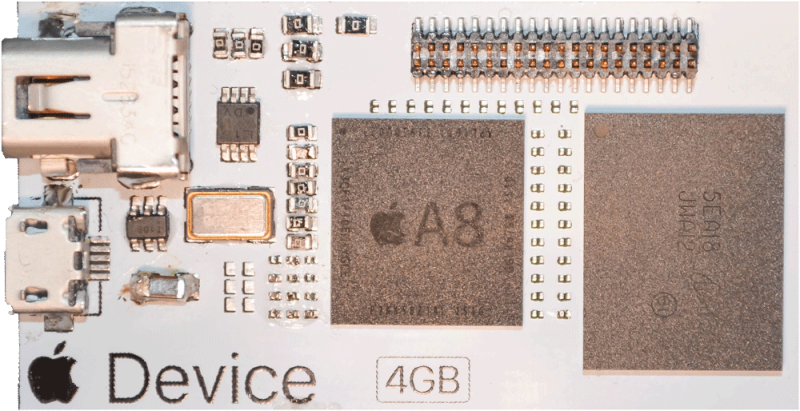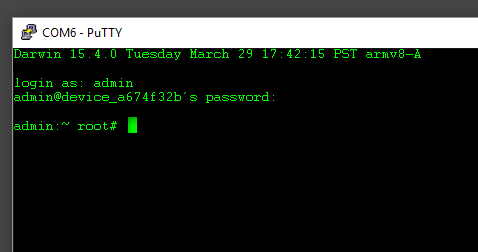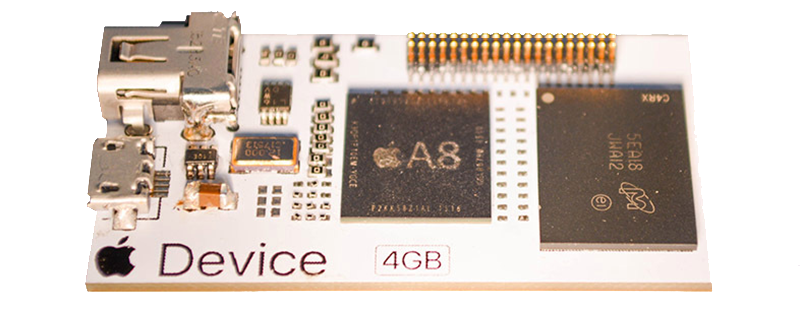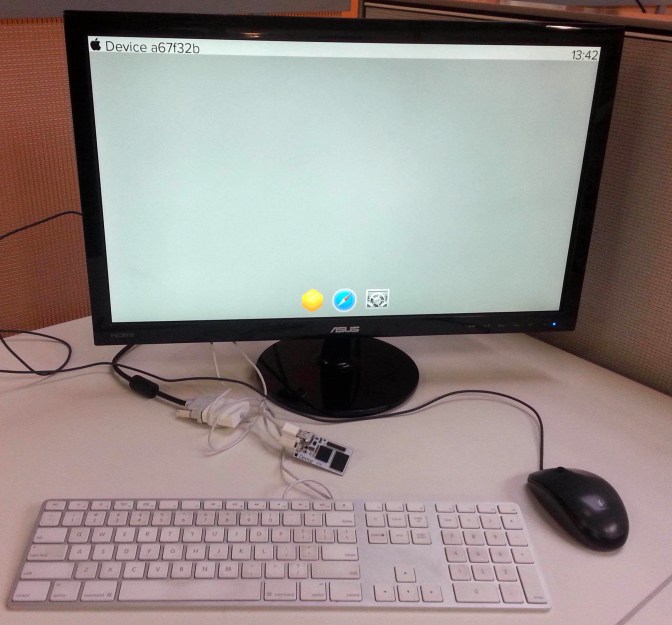Today, Apple has announced their latest bit of hardware. Following in the tradition of the Raspberry Pi, BeagleBone, and the Intel Edison, Apple have released a single board computer meant for embedded and Internet of Things applications. It’s called the Apple Device, and is sure to be a game changer in the field of low-power, Internet-enabled computing.
First off, some specs. The Apple Device uses Apple’s own A8 chip, the same dual-core 64-bit CPU found in the iPhone 6. This CPU is clocked at 1.1 GHz, and comes equipped with 1GB of LPDDR3 RAM and 4GB of eMMC Flash. I/O includes a Mini DisplayPort capable of driving a 4k display, 802.11ac, Bluetooth, and USB. In a massive break from the Apple zeitgeist of the last decade or so, the Apple Device also includes a forty pin header for expansion, much like the Raspberry Pi, BeagleBone, and Edison.
Although Apple’s first foray into the embedded computing market is a shocker, in retrospect it should come as no surprise; the introduction of HomeKit in iOS 9 laid the groundwork for an Internet of Apple Devices, embedded into toasters, refrigerators, smart homes, and cars. The Apple Device lives up to all these expectations, but what is the hands-on experience like?
See our review of the Apple Device after the break.

The first question anyone should ask when discussing an Apple Internet of Things board is, ‘what operating system does it run?’ This is, by far, the most pressing concern – you don’t need a purely graphical OS with a headless machine, and you don’t want an OS that is locked down with proprietary cruft.
Of course. the idea that Apple is built upon proprietary and locked down operating systems is a myth. iOS and Mac OS are built on Darwin, an open source kernel based on BSD. This is the core of the DeviceOS, and booting the device (through a terminal, no less!) provides everything you could ever need in a tiny, single board computer.
Apple isn’t committing themselves to a purely command line board here, though. Apple hasn’t built a computer like that for more than 30 years. There’s a Mini DisplayPort on the Apple Device, and of course that means a GUI. It’s obviously not as capable as the full feature OS X, but it is very useful. It’s not iOS, either; I’d compare it to a Chromebook – just enough to do the job, and not much else.
User Experience

While the Apple Device is intended to run headless most of the time, in fact it’s how Apple expects you to set this device up.
To power the device, all you need to do is connect the Device to a computer and open up a terminal. This drops you into the Device’s shell, with access to the entire unix-ey subsystem. Once the WiFi credentials are set, just unplug the device from the computer, plug it into a micro USB charger, and the Device is connected to the Internet.
This USB port isn’t just for power – it’s also the way to connect keyboards, mice, peripherals, and USB thumb drives. You will, however, need the Apple Powered Device USB Hub (sold separately), that breaks out the USB into four USB Type A ports while backpowering the Apple Device. It’s a brilliant physical user interface for a device that will run headless most of the time, but still requires a few ports to be useful.
Of course, if you’re not running the Apple Device headless, you’ll need to connect a monitor. This is where the Mini DisplayPort comes in. Boot the device with the Powered Device USB Hub, plug in a monitor, and you’re presented with a ‘desktop’ that’s not really OS X, and it’s not really iOS, either. It’s minimal, and almost chromebook-esque.
The OS looks a little bit like OS X, but it’s not. Right now, the only programs available for the DeviceOS are the HomeKit app, the Safari browser, and playing around with the settings. If you want to look something up on the Internet, just click on the Safari icon. If you want to change the WiFi address or the device name, just go into the settings.
Configured as a Desktop, you can see the brilliance of Apple in the Device. It’s not a desktop computer, but neither is a Chromebook. Considering most people can do most of their work on the web, this is a game-changing device. Combine it with Apple’s iCloud, and you have something that will be exceptionally popular.
The Downside of Apple
Apple has their hands in a lot of cookie jars. The Apple TV is their device for streaming videos and music to a TV. Giving the Apple Device this functionality would cut into sales of the Apple TV. Since the Apple Device sells for $100 less than the Apple TV, this would be a bad move, even if Apple is sitting on Billions in cash.
Also, even though the Apple Device has a 40-pin header right on the board, there is no documentation anywhere of what these pins can be used for. The Raspberry Pi’s 40-pin header is well documented and can be used for everything from environmental sensors to VGA and audio output. Apple makes no mention of what these pins can do, although we do expect a few ‘shields’ to be released in short order.
Benchmarks
Built around the Apple A8 chip, the Apple Device is extremely capable, especially compared to its assumed competitors, the Raspberry Pi and Intel Edison.



In terms of raw horsepower, the Apple Device handily beats out the Raspberry Pi 2 and the Intel Edison. This should be expected. The A8 chip in the Apple Device is extremely powerful and beats the other single board computers handily.
But what about graphics? The GPU in the Raspberry Pi is a huge reason why that board is popular, and being able to stream a few movies to the Apple Device would mean the Apple TV will be quickly taken out of production.
3D acceleration is better, but when it comes to h.264 encoding, the Apple Device falls a little short. Even compared to the rather sluggish Raspberry Pi Zero, the Apple Device is no match for the berry boards.
This is purely speculation, but I suspect h.264 encoding is disabled in the Apple Device. The reason is clear – Apple already sells a single board computer meant for streaming video to a TV. Giving the Apple Device the same capabilities as the Apple TV would cut into that market. Sadly, it looks like the video capabilities of the Apple Device are limited to digital signage. That’s disappointing, but given Apple’s strategy for the last twenty years, not unexpected. We do look forward to the eventual hack, root, or exploit that will unlock the powerful graphics capabilities the A8 chip already has.
Verdict
Right off the bat, the Apple Device is an amazing piece of hardware. It’s incredibly small, has a lot of computational power, and works with all the HomeKit devices you already own. The ability to just plug it into a computer and have a tiny *nix device connected to the Internet is great, and comparing the user interface to the Raspberry Pi, Beaglebone, or any of the Intel offerings isn’t even a fair comparison. Apple has taken the best design from their entire product line that anyone – including engineers and the tech literati – would find useful.
However, there are a few glaring limitations of the Apple Device. h.264 decoding is a big one, as the most popular use case of the Raspberry Pi seems to be setting up retro game emulators and streaming video from a network. Apple does what Apple will do, and the Device would probably cut into the market for the Apple TV.
Another shortcoming is the issue of the 40-pin header. Right now, there is no documentation whatsoever for the very small pin header located on the board. I couldn’t find anything in the *nix system relating to peripherals that might be connected to those pins. In any event, the pins are on a 1.0 mm pitch, making it very hard to plug a scope or meter onto one of those pins if you don’t have the mating connector. If anyone has seen this connector in the wild, I’d love to hear about it in the comments.
What Apple has done here is no different from the Raspberry Pi or any of the other ARM-powered single board computers released in recent years. They’ve taken a CPU from a smartphone that is now a few years old, added a few peripherals, and slapped it on a board. By itself, this is nothing new. That’s exactly what the Raspberry Pi is, and what all of the Raspberry Pi ‘clones’ are, from the Banana Pi to the Odroid.
While the hardware is somewhat predictable, the software is where this really shines. It’s not built for iOS, given this device is designed to run headless most of the time. It can be used purely through a command line, making this the perfect device for the Internet of Things. It’s also a tiny desktop computer, and somewhat usable given the power of the A8 chip. Since the Apple Device sells for about $50, Apple really hit it out of the park with this one, despite the obvious and not so obvious shortcomings. We’re really looking forward to Apple taking the popularity of the Raspberry Pi and other single board computers to the next level, and this is the device that will do it.
As a quick aside, it should be noted the Apple Device is technically Apple’s second single board computer. The first Apple product, the Apple I, released in 1976, would today fall into the same market as the Raspberry Pis, Beaglebones, and now the Apple Device. If you take the launch of the Apple I to be the date Apple was founded (April 1, 1976), today is the 40th anniversary of the first Apple product. The Apple I is now a museum piece and the finest example of Apple’s innovation over the years. The Apple Device follows in this tradition, and is nearly guaranteed to be held in as high regard as the board that came out of the [Steve]s’ garage.



















Preferred the eevblog post
I liked his new office video. (old Altium building) :P
If this were real just imagine all the projects we would see here where hipsters use it to control an RGB head lamp on a single speed bike…
Ugh
Well done! A lot of effort went into this spoof.
Well played, sir! But yes, it would have been called iDevice, it would cost $400, the USB plug would be non-standard and there would not be an expansion header. And people would be in line at the Apple store to buy one :)
You would have to wait for someone to release a jailbreak before you could program it, after you shelled out $199 for it.
I knew it was an April fool, since it had a micro usb instead of a lightning port. That’d be so un-Apple to make something that they can’t sell adapters for!
I have to say, though, this is starting to feel like The Onion. You can absolutely see Apple doing this, overpricing it, underpowering it, and it selling like wildfire.
A good one. I almost believed it :-)
At first I though “really?! Well this is not TOTALLY implausible”. Then I saw the board images and thought “well, these ones are obviously fake, Apple are actually good at designing hardware (and no PCB will look like that”. Entertaining to read, but not very convincing…
The greatest thing to come from them since the Newton. I’m already standing in line for one.
Trollolol.
So, ok, this one is in the running for sure.
Happy April’s fools!!
I was so focused on why h.264 encode would matter when I want to use h.264 decode for tv. I missed the lack of network connectivity.
Putty pictures distracted me.
Incredible. I read the whole thing and google searched too…
Haha April fool am I
Sent from my iPhone
>
I knew it was an April fool as soon as I saw the soldering on that board! Also it wouldn’t have USB it would have a lightning connector :)
It’s too big for an Apple IoT device (needs to be the size of an iWatch, but with wrist-pinching pins to be powered by blood), but a great fool :)
Fuck right off. I read the whole things. Are we in middle school?
This is clearly a fake. Anybody with adobe after effects could fake that video. Also, Tesla was the real hero.
You forgot to add the line:
“Starting from $699”.
Can we not do this? Can we please not participate in April fools?
Come on Hackaday, you’re better than this.
Hahahahaha, great i love this. April 1
Spent 10 minutes staring at all the zero ohm resistors.
How about some real Raspberry PI news? https://forum.xojo.com/31389-omegabundle-for-xojo-2016-extended-no-april-fools-but-fun-raspb
April Fool ??
I am going to stop reading Hackaday for a day or two til this nonsense settles down.
Had me going for a second…it just didn’t seem right though. Nice try though. ;)
Man the soldering on that thing is awful. Nice try, happy April 1st.
Alpha tested it. Unfortunately any and all hardware in MUST be apple certified. HOWEVER, the first 10 devices WILL be UPGRADED to apple certified AFTER you connect it and sycronize AND have the firmware re-flashed. Down side is it is all devices are now locked to the dev board. Works great re-flashing your DMM, Logic Analyzer, Bench PSU AND ALL types of Oscilloscopes. It is also white pcb and you can the see the chips there. It has connectors with holes. And it has a logo. It tells you what it is. And how much memory it can have.
April 1st changes everything…. in the article.
ha….
ha
ha
ha…..
April 1st! I didn’t think Tim Cook could go this far off the deep end. Might as well dig up ol’ Steve and spray paint a Windows symbol on his casket.
Haha, you got me.
I knew this was a load of crap the minute I saw it. In no way, would Apple make a device like that, and if they did, what do you think it would go for? You guessed it! $499…. $599? Seriously, I doubt Apple would ever make such a device, the closest is the Apple Watch, that’s it… I’m done. *drops mic*
Even if the Apple Device is a joke, you know you want one!
What would have really made this complete would have been a photoshop still frame of Tim Cook doing a keynote with a picture of one behind him.
This has got to be the single most creative and sophisticated april fools joke I have ever read. Down to an OS anaylsis! I love this. Well played.
It would be called “the i”
While I didn’t read the whole thing, I did search the entire WWW and found NOTHING!!!!
Interesting, it is very small. Building up a Server cluster with such micro machines might be interesting to run cloud instances.
April fools.
Poor soldering job.
Jumper resistors everywhere. “Insert Toy Story Meme here”
Using PuTTY with a “Apple” device.
Should have been called apple pi…
Glad you compaired it to hardware over year old. Well done.
A ton of zero ohm resistors on there kinda gives it away.
What, their answer doesn’t involve a lawsuit, or a dumb copyright. Must be BS!
I forwarded a link to this to someone with a title that said “Apple PI”, hit send and then realized, upon reading my title, that I’d been HAD.
Really good prank .. best one I have seen in quite some time.
Got me! I believed it till I read the part about Open Source / Closed Source and realized, this can’t be true…. and uh, oh — Oh, I get it, it’s April. Haaaaaaah!
i know this ia april fools, but the kernel is based on mach not BSD as you implied, bsd is just the userland
Please tell me you actually made a dummy PCB just for the pics
Good to see Apple playing deeper in connected things. However I think the comparison should have been with Raspberry pi 3 and not 2. Nice piece.